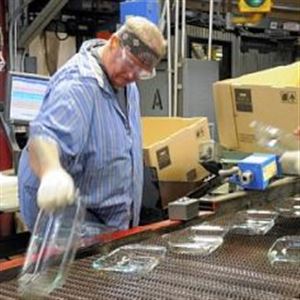CHARLEROI — This small Monongahela River town an hour south of Downtown is home to the only factory in the world that produces Pyrex bakeware.
An estimated 75 percent of American households own at least one piece of Pyrex, so that's a lot from this factory.
As in 400 million pieces in the past 10 years.
As in 100,000 to 150,000 pieces made every day.
And Pyrex has been a staple of American kitchens for nearly 90 years.
It came into being through the creative thinking of a railroad glass scientist in Corning, N.Y. Working to produce lanterns that could get hot on the railroad but not shatter when hit by rain and snow, the scientist took home a scrap piece of his heavy-duty glass for his wife to bake a sponge cake. The rest, as they say, is history.
The glass's possibilities as bakeware were immediately apparent, and in 1915, Pyrex dishes appeared on the commercial scene.
Pyrex doesn't come in as many colors and styles as it used to. The nesting mixing bowls (each a different, bright color within the same four-piece set), the shallow red-and-white rectangular pieces intended for refrigerator stacking, and the covered casserole dishes with designs on the sides are all things of the past.
In fact, some have become collectors' items -- don't throw away Granny's Pyrex when she moves out of her house!
New products
Despite the reduced number of colors and designs available, Pyrex has expanded its offerings in other ways.
True, most Pyrex is clear glass, with cobalt blue-, light and dark green-, and amethyst (purple)-tinted lines also available in some stores, plus amber-tinted dishes produced for Europe and Asia only.
But Pyrex keeps changing with the times. Many Pyrex containers are made with vented plastic lids for microwave reheating. Those lids can be placed face-down on the counter, and the Pyrex containers can be pressed right into them to be stored together -- a boon for people who can never find a lid to fit a storage container.
Pyrex Simple Elegance products allow people to bake and serve food from the same dish. One example is a classy glass bowl that is safe in the oven but also looks nice on the table.
Pyrex Portables, another newer product, are the standard 9-by-13-inch glass baking dishes, but they come with a plastic lid, a carrying case and a microwaveable hot-pack that allows cooks to keep their dishes warm on the way to a potluck.
One of the newest products is a measuring cup with "reverse" decoration -- it's printed on the inside as well as the outside, so when the cook pours a liquid into the cup, he or she can simply read the inside line to see when the liquid has reached the proper measurement. The same measuring cup also comes with a four-position lid, allowing cooks to pour, strain, sift or simply cover the cup for storage.
Though the factory makes more than 200 products, the old standbys are still the biggest sellers: the plain old everyday measuring cups; the 8-by-8, 9-by-9 and 9-by-13-inch clear-glass baking dishes; pie plates; and little custard cups (or what our family used to call "ice cream bowls"). Some things never go out of style.
Pyrex as a whole doesn't show any signs of going out of style, either, despite the rise of competitors over its 90-year history. Plastics, in particular, changed the face of the industry with Tupperware, Rubber Maid and even disposable plastic containers being preferred by some cooks for food storage.
But as Pyrex brand manager Sarah O'Neil points out, Pyrex has a leg up on plastics because it doesn't absorb food odors, flavors or stains, and it's safe for microwave reheating. So it's not likely to lose its relevance anytime soon.
"Pyrex is part of our culture the way Ford is part of our culture," she said. "It's part of Americana."

![]() Robert J. Pavuchak, Post-Gazette photo
Robert J. Pavuchak, Post-Gazette photo
Soltis, press operator at the Pyrex factory in Charleroi, monitors the temperature of the production line pressing hot glass gobs into molds to make 9-by-13-inch purple utility dishes, a process known as the forming stage.
Click photo for larger image.![]()
A little history
Pyrex has been manufactured in Charleroi since 1936, when Corning bought what was then the Macbeth-Evans plant. The plant opened in 1893 as a manufacturer of glass lamp chimneys, and over the years it produced myriad items, including glass for boats, trains and cars; lighthouse lenses; streetlight globes; optical glass used in telescopes; and cathode ray tubes for television and radar, as well as tableware and bakeware by the thousands of tons.
At its peak, the factory employed more than 2,100 people in 15 two-story buildings. Today it employs about 320 and is owned by World Kitchen, which bought Corning's consumer products division in 1998.
Many people in town still refer to it as "the Corning plant" because that's what it was for more than 60 years.
Townsend Jackson, the Charleroi plant manager, describes Pyrex as "a combination of special materials and a heat treatment process."
It's that heat treatment, in particular, that gives Pyrex its ability to withstand very high temperatures -- temperatures found in a home oven or even as a rocket ship re-enters Earth's atmosphere.
Pyrex was used as the glass in the windows of the Apollo and Gemini spacecraft in the 1960s and '70s.
In Pyrex's two-part name, pyr comes from the Greek word pyro, or fire, referring to the high temperatures the glass can withstand. Ex refers to the type of glass it is -- nonexpansion, or glass that does not change shape when it is heated and cooled.
For the purpose of easy explanation, Jackson likens the early steps of making Pyrex to the process of baking a cake:
 Mixing.
Mixing.
Jackson says they start with a "recipe" -- a list of ingredients and the amount needed. The primary ingredient is silica sand, which used to be mined in nearby Speers but is now shipped in by railcar from Mapleton, Huntingdon County.
Seven additional ingredients are used. The raw materials, which are shipped in by railcar or truck, are dumped through chutes into underground pits. From there, they are conveyed to hoppers in the mixing room, where a fully automated system installed less than a year ago weighs each ingredient in a separate hopper. The system makes multiple checks to ensure the correct weights of ingredients have been used -- an important step because even a relatively slight variation could result in defective dishes.
Once the ingredients have been measured, they are combined into a "batch."
 Melting.
Melting.
Here the cake-making analogy breaks down. Jackson says you could think of this step as the baking process, but in this case the ingredients transform from solid form to liquid form -- the opposite of what happens when you bake a cake.
The batch of ingredients is dumped into a furnace kept at about 3,000 degrees, where it turns to bright-orange, glowing-hot molten glass.
As it travels out of the furnace, it is cut with shears into portions known as gobs.
 Forming.
Forming.
The bright-orange gobs drop into molds shaped like measuring cups or pie plates or casserole dishes -- whatever is being made on a particular day. The molds are situated on a wheel that turns continually.
A heavy press descends onto the gobs, pressing the molten glass into the shape of the mold. The uneven edges are then smoothed on top of fiery, glowing burners.
This is the most stunning step of the process from a visual perspective.
 Tempering.
Tempering.
Quality manager Mary Lou Grachen, a 22-year veteran at the plant, explains this crucial step gives Pyrex its heat-resistant qualities.
The dishes enter the tempering area at about 600 degrees and are heated to 650 degrees. They are then cooled immediately to about 150 to 200 degrees -- cool enough for inspectors to pick them up with gloves.
 Inspection.
Inspection.
Workers check each individual piece for defects, throwing any damaged pieces out for use in another batch of glass.
Previously made glass is one of the ingredients that goes into every new batch of glass.
 Packing and shipping.
Packing and shipping.
The items go to a distribution center in Greencastle, Franklin County, and from there they are shipped all over the world.
 Printing.
Printing.
For the measuring cups only, one special step is included before tempering: adding the red enamel lines that indicate the proper measurements. Pyrex used to come in a variety of designs -- homemakers of varying ages remember brightly-colored Pyrex bowls with flowers, hens, snowflakes, grape clusters and other patterns that were the fashion of the day.
Now, the measuring cups are the only items that are printed, using what production superintendent Doug Chamberlin calls "a simple screen."
He noted that the printing section of the factory now operates only half the year because so few items are printed.
Whether the Pyrex is plain or printed, its name is synonymous with families and friends getting together to enjoy some good food.
TARRAGON CHICKEN IN WHITE WINE
- 3/4 cup dry white wine
- 1/4 cup fresh lemon juice
- 2 tablespoons olive oil
- 1 clove garlic, minced
- Salt
- 1 broiler-fryer chicken (2 1/2 to 3 pounds), cut up
- Paprika
- Freshly ground pepper
- 1/2 cup heavy cream
- Dash of Worcestershire sauce
2 teaspoons fresh tarragon or 1 teaspoon dried
In 9-by-13-inch Pyrex baking dish, combine the wine, lemon juice, oil, garlic and 1 teaspoon salt; blend well. Add the chicken pieces, turning to coat. Refrigerate, with the plastic cover on, for at least 3 hours, turning the chicken from time to time. Preheat the oven to 375 degrees. Sprinkle the chicken with paprika and pepper. Bake for 45 to 55 minutes or until fork tender. Remove the chicken from the oven and reduce the oven temperature to 200 degrees.
Transfer chicken to a platter and pour remaining juices into separate saucepan. Place platter in oven to keep warm while making the sauce. Over medium heat, reduce the pan juices to 1 1/2 cups. Add the cream and heat to the boiling point. Add Worcestershire sauce and tarragon; taste and adjust the seasonings. Pour the sauce over the chicken and serve on a bed of rice or pasta. Serves 4.
Pyrex
GLAZED BAKED HAM
- 1 ready-to-eat ham with bone, or boneless, or spiral cut
- 2 cups apple juice
- 1 cup apricot preserves
- 2 tablespoons Dijon mustard
Preheat oven to 325 degrees.
Place ham in 9-by-13 Pyrex baking dish with apple juice. Bake in oven for 1 1/2 hours.
Meanwhile, in a small bowl, mix apricot preserves and mustard together to make a glaze. After 1 1/2 hours of baking ham, spoon half of the apricot/mustard mixture over the ham. Continue baking for 15 minutes; spoon remaining glaze over ham.
Continue to bake for 15 to 30 minutes, until ham is browned and glazed. Transfer ham to a large serving platter and skim the fat from the pan juices, and pour into a sauce boat.
Allow ham to sit 15 minutes before slicing. Serve with pan juices and mustard if desired.
Pyrex
FRESH BLUEBERRY CRUMBLE
- 3 cups fresh blueberries
- 1/2 cup sugar
- 3 tablespoons all purpose flour, plus 3/4 cup for topping
- 1/2 cup brown sugar
- 1/2 cup quick cooking or old fashioned rolled oats
- 1/2 cup butter (1 stick), cut into 10 pieces (we cut it smaller)
Preheat oven to 350 degrees. Rinse berries with water and place in a colander to remove excess moisture.
Into 8-inch square Pyrex baking dish, pour berries, sprinkle with sugar and 3 tablespoons flour, mix together and spread evenly in bottom of dish. Into a medium mixing bowl, place 3/4 cup flour, brown sugar, oats and butter. Mix together with hands until crumbly. Sprinkle evenly over the top of the blueberries. Bake in preheated oven for 30 to 35 minutes until fruit is bubbling through topping. Serve warm with ice cream or whipped cream. Serves 6.
Pyrex
First Published: October 7, 2004, 4:00 a.m.

















